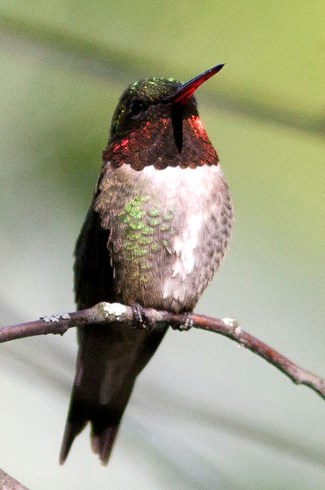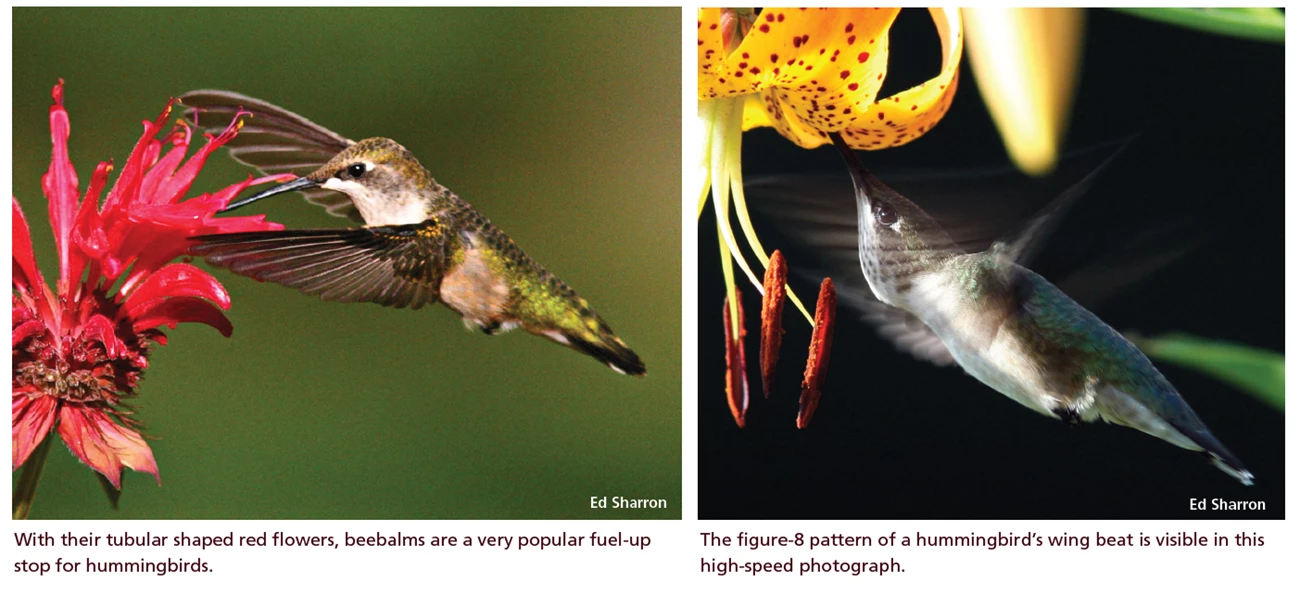Last updated: August 15, 2021
Article
NETN Species Spotlight - Ruby-throated Hummingbird


Ed Sharron
What is it?
3,860,000. That’s how many times a Ruby-throated Hummingbird could flap its wings without a break on a 500-mile, 18-20 hour migratory flight across the Gulf of Mexico. For comparison, the average adult human would only cover about 60 miles if they walked nonstop during that same time span. Pretty impressive for a bird that weighs less than a U.S. 5-cent nickel when it makes its departure in the spring.Mature males are easily recognized by their bright-red iridescent throat patch. Females and young males lack the red patch but still display jewel-green iridescent feathers over their heads and down their backs.
Aerial Acrobats
Possessing the ability to hover, fly forwards, backwards, straight-up, even upside-down, and at speeds up to 60 miles-per-hour when diving, these little aerialists make all other birds look slow and plodding by comparison. On more than one occasion they’ve even been observed doing backwards somersaults in pursuit of tiny insect prey. They are able to achieve these flights-of-fancy through wing movements unique to the bird family. They don’t so much flap their wings as they do rotate them in a figure eight pattern - at a rate of about 50 times per second. This generates lift on both the forward and backward strokes, allowing for rock-steady hovering and practically instantaneous direction change on-the-wing through only a slight adjustment of wing-angle.
Scientists are used to seeing this ability among insects, such as with dragonflies, but this wing-pattern is unique in the bird world. Science is still learning how hummingbirds are able to achieve their fascinating flight. Complex research techniques that involve ultraviolet light and wind tunnels are helping to improve our understanding of exactly how hummingbirds fly.

Welcome to the Gun Show
You wouldn’t know it to look at them, but Ruby-throats are packing some pretty serious muscle under those shiny feathers. In order to achieve their powerful flight, they have relatively enormous pectoral (chest) muscles, making up about 25-30 percent of their total body weight.Other flight adaptations include very tiny feet which only allow them to kind-of scoot along a perch, but shave-off excess weight that would otherwise slow their flight, and a large heart (beating 1200 times per minute) to supply those wing-muscles with plentiful oxygen.
Extreme Sugar Rush
By July in the Northeast, many flowers and gardens are finally reaching full blooming capacity. Like a kid in a candy store, hummingbirds are busying themselves buzzing from flower-to-flower to suck up as much sugary nectar as they can. Because they burn so many calories a day to power their flights, hummingbirds need to eat a lot - almost constantly during daylight hours. An adult Ruby-throated hummingbird can eat twice its body weight each day. Much of this is consumed in the form of nectar, but these birds are actually omnivorous. They’ll also eat spiders, tiny flies, gnats and aphids for fats and protein. This is especially important when bulking up to attempt a Gulf of Mexico crossing during migration. They almost double their body weight (3.25 grams to 6 grams) during this time.Who You Callin’ Yellow-bellied?
When Ruby-throats begin arriving on their breeding grounds in the northeast in April and May, there are relatively few nectar-rich blooming flowers on which to feed. Enter: the Yellow-bellied Sapsucker. Though it’s name sounds like an insult to be hurled around a schoolyard, it is actually a species of woodpecker that breeds in the Northeastern U.S., and is a special friend to the Ruby-throated Hummingbird. Sapsuckers winter in the southeastern U.S. and Central America and migrate north in the early spring when the tree sap starts flowing on which they feed. Analysis shows that tree sap is very similar to the nectar hummingbirds take from flowers with both containing sucrose and trace amounts of amino acids. The relatively deep tap-holes used by maple syrup makers pulls sap that contains about 2-3 percent sugar. The shallow wells created by Sapsuckers, however, tap into phloem sap, which contains up to 20-30 percent sugar.
Ruby-throated Hummingbirds take full advantage of these sugar-rich sapwells, especially in early spring, but throughout the summer as well. They feed not only on the sap but also the tiny insects that are attracted to them. Hummers have been observed closely tailing sapsuckers as they fly from one sap tree to another. They’ll even chase away other bird species who visit the wells, leaving the Sapsucker to slurp in peace and maybe drill more holes for them both to feed on.
For more information
-To see slow-motion video of a Ruby-throated Hummingbird’s wings, see this video on YouTube.
- Follow this link for info on NETN’s long-term Breeding Landbird monitoring program .
Download a printable PDF of this article.
Tags
- acadia national park
- appalachian national scenic trail
- eleanor roosevelt national historic site
- home of franklin d roosevelt national historic site
- marsh - billings - rockefeller national historical park
- minute man national historical park
- morristown national historical park
- saint-gaudens national historical park
- salem maritime national historical park
- saratoga national historical park
- saugus iron works national historic site
- vanderbilt mansion national historic site
- weir farm national historical park
- species spotlight
- netn
- hummingbird
- bird
- birding
